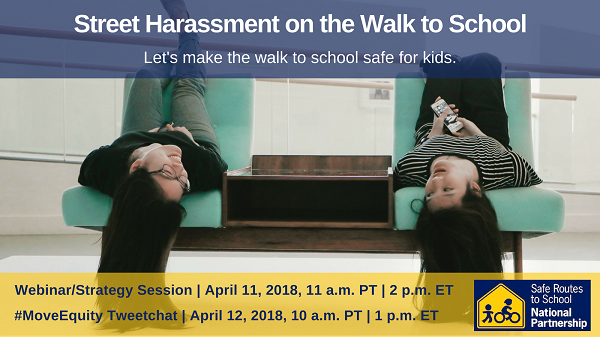
Over the past few months, a wave of righteous anger and adamant rejection of widespread sexual harassment has brought down more than 100 powerful men in a long overdue reckoning. As a society, we are wading into the turbulent waters created by centuries of ignoring women’s pain and humiliation while blaming women for male harassment. Unsurprisingly, the results are messy.
While it is hard to imagine men’s psyches returning to the smug invulnerability that existed just six months ago, it is also clear that the work of the #MeToo movement is just beginning. We will need much more work if this moment is going to measurably increase safety and opportunities for women who are not famous—for regular women and girls in our schools, on our streets, and around us, and particularly for women and girls of color, low-income women and girls, and for LGBTQ individuals.
Street harassment is where #MeToo connects to our work on Safe Routes to School and active communities. Girls and women regularly experience street harassment in public spaces, and surveys show that many women of color, women with disabilities, and LGBTQ individuals experience this harassment more frequently and more intensely.
Street harassment may seem trivial when compared with the brutal assaults and crass demands for sexual favors reported in the news. But being hassled and propositioned by male strangers in public teaches girls a deep and hurtful lesson about how our society perceives their worth as human beings. Street harassment also shows girls the willingness of bystanders to ignore their mortification and accept their mistreatment. Street harassment isn’t trivial; it affects girls’ comfort in public spaces, how they understand their place in their communities, and whether they develop habits of physical activity that support lifelong health. What our programs and institutions do and don’t tell girls about how to respond to this first arena of harassment sets the stage for how girls understand their right to safety and respect throughout their lives.
Yet schools, youth programs, and Safe Routes to School programs are often silent on the topic of street harassment. Instead of getting credible tools for emerging stronger through understanding the experience of harassment, young people are left to cobble together advice from family members, peers, and strangers on social media sites—advice that sometimes reinforces the damaging culture behind the harassment.
This is unacceptable. We know that street harassment creates shame about maturing, discourages girls from healthy ways of getting around their communities, can affect academic performance, and can escalate into physical attacks. If Safe Routes to School work is intended to create strong and healthy kids who are ready to help build healthy communities, then all of our programs need to take on street harassment.
For the past several years, the Safe Routes Partnership has encouraged Safe Routes to School programs to actively address street harassment issues. Our report on Wolf Whistles and Creepy Compliments spells out why street harassment matters for Safe Routes to School and details strategies for reaching girls and boys on this important issue. Our talking points emphasize what young people and the people who work with them need to know:
- Street harassment is not a compliment. Seemly mild comments and casual jokes can be scary or offensive. Street harassment is not the fault of or caused by the person being harassed.
- Street harassment is very common and it starts young—harassment starts by age 17 more than 50% of the time. More than 15% of women who have experienced sexual harassment or assault report that it began when they were 11 to 13 years old and 27% report that it began when they were 14 to 17 years old.
- Street harassment can have a serious emotional impact, causing depression and anxiety, and can affect girls’ travel to school, performance in school, and their willingness to be in public spaces.
- Students, teachers, and other adults often misunderstand how it feels to be harassed, which can have harmful or confusing effects for those experiencing harassment.
- Despite long-held beliefs, street harassment is a public concern, not just a private experience. The engagement of Safe Routes to School programs, schools, and other institutions in stopping street harassment is critical to creating a world where everyone feels safe and welcome in public places.
It is past time for Safe Routes to School programs to address this issue. Acknowledging that street harassment exists, and that girls, youth of color, and LGBTQ youth have different obstacles to lifelong walking & biking is the first step. Our culture will change when our programs and institutions consistently teach boys not to harass and teach girls that they deserve better and can demand more. It is time to engage with this work.
Tell us what you think! Join our #MoveEquity street harassment tweetchat on Thursday, April 12th at 1 pm ET and our webinar on street harassment on Wednesday, April 11th at 2 pm ET.

